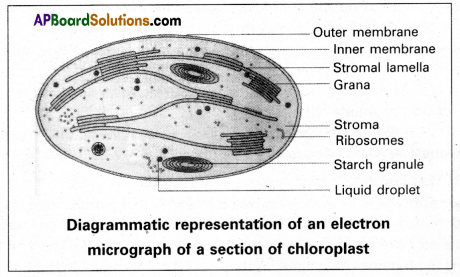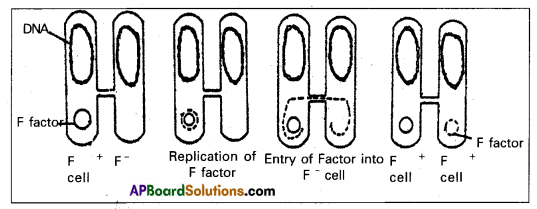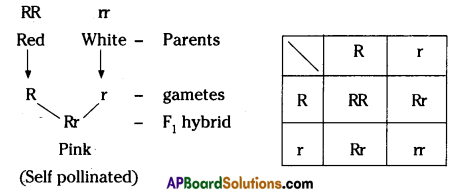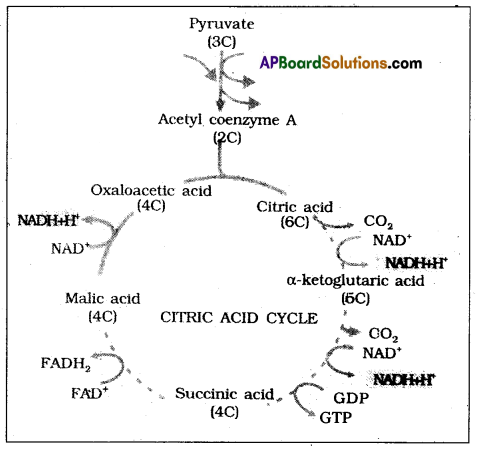Thoroughly analyzing AP Inter 2nd Year Botany Model Papers and AP Inter 2nd Year Botany Question Paper May 2016 helps students identify their strengths and weaknesses.
AP Inter 2nd Year Botany Question Paper May 2016
Time: 3 Hours
Max. Marks: 60
Note: Read the following instructions carefully
- Answer All the questions of Section A. Answer any SIX questions out of eight in Section B and answer any TWO questions out of three in Section ‘C.
- In Section ‘A’, questions from Sr. Nos. I to 10 are of very short answer type”. Each question carries TWO marks. Every answer may be limited to 5 lines. Answer all the questions at one place in the same order.
- In Section B, questions from Sr. Nos, 11 to 18 are of short answer type”. Each question carries FOUR marks. Every answer may be limited to 20 lines.
- In Section C, questions from Sr. Nos. 19 to 21 are of long answer type. Each question carries EIGHT marks. Every answer may be limited to 60 lines.
- Draw labelled diagrams wherever necessary for questions in Section B.
Section – A
10 x 2 = 20
Note: Answer All the questions. Each answer may be limited to 5 lines.
Question 1.
How does guttation differ from transpiration?
Answer:
| Guttation | Transpiration |
| 1. The loss of water from the leaves in liquid form. | 1. The loss of water in the form of water vapour. |
| 2. it occurs usually at night. | 2. It occurs usually during the daytime. |
| 3. It occurs through vein endings. | 3. It occurs through stomata. |
| 4. it is an uncontrolled process. | 4. It is a controlled process. |
Question 2.
Distinguish between apoenzyme and co-factor.
Answer:
- The protein part of the Holoenzyme is called apoenzyme.
- The non-protein part of the Holoenzyme is called the co-factor.
Question 3.
What is a prophage?
Answer:
The phase DNA which is incorporated into bacterial DNA is called prophase.
Question 4.
What is point mutation? Give an example.
Answer:
Change of single base pair in the gene for beta globulin chain that results in the change of amino acid residue glutamate to valine. It results in a diseased condition called ‘sickle cell anaemia’.
![]()
Question 5.
Given below is the sequence of coding strands of DNA in a transcription unit:
3’AATGCAGCTATrAGG -5.
Write the sequence of:
a) Its complementary strand
b) The mRNA
Answer:
a) 5’TACGTCGATAATCC -3’
b) 5’AAUGCAGCUAUUAGG – 3’.
Question 6.
Write any two chemical differences between DNA and RNA.
Answer:
| DNA | RNA |
| 1. Deoxyribose sugar is present. | 1. Ribose sugar is present. |
| 2. Adenine, Guanine, Thymine and cytosine are nitrogen bases. | 2. Adenine, Guanine, uradil and cytosine are nitrogen bases. |
Question 7.
What is downstream processing?
Answer:
Separation and purification of products before they are ready for marketing is called downstream processing.
Question 8.
Give one example for each of transgenic plants which are suitable for food processing and those with improved nutritional quality.
Answer:
Flavr Savr suitable for storage. and transport, Golden rice Taipei is rich in Vitamin — A and prevents blindness.
Question 9.
What is meant by hidden hunger?
Answer:
It is a chronic lack of vitamins and minerals that often has no visible warning signs. It leads to mineral impairment, poor health and productivity or even death.
Question 10.
Name the scientists who were credited for showing the role of penicillin as an antibiotic.
Answer:
Ernst Chain, Howard Florey and Alexander Fleming.
![]()
Section – B
6 × 4 = 24
Note: Answer any SIX questions. Each answer may be limited to 20 lines.
Question 11.
Explain pressure flow hypothesis of translocation of Sugars in plants.
Answer:
Glucose is prepared at the source is converted to sucrose, then moved into the compànion cells and then into the living phloem
sieve tubes by active transport. Water from the adjacent xylem cells moves into the phloem by osmosis. As osmotic pressure builds up, the phloem sap moves to the cell which will use the sugar, converting into energy, starch or cellulose as sugars are removed, the osmotic pressure decreases and water moves out of the phloem.
To explain this, Munch conducted one experiment in which he took two osmometers A and B. In E he took concentrated sugar solution and in ‘A’ he took pure water and both are connected by ‘C’ tube. He then placed A and B bulbs in pure water tubs X and Y, which are connected by Z tube. Due to osmosis, water moves from A to B, from B to A via C and then A to X and finally X to Y through Z until the equilibrium is attained. In this experiment, he compared B bulb with source, A bulb with sink, C tube with phloem. /x and Y tubs with xylem and z with plasmodesmata.
Question 12.
Explain the nitrogen cycle, giving relevant examples.
Answer:
The cyclic movement of Nitrogen from atmosphere to soil and from soil to atmosphere through plants, Animals and microorganisms is called nitrogen cycle. It involves 5 steps.
- Nitrogen fixation: The process of conversion of molecular nitrogen to ammonia or nitrogen oxides, nitrites and nitrates is termed as Nitrogen fixation. It occurs by physical method or by biological method. Ex: Acetobactor Rhizobium.
- Nitrogen assimilation: The process of absorbing nitrates, ammonia and chemically binding the nitrogen with other elements to produce organic nitrogen in plants and into animals is called Nitrogen assimilation.
- Ammonification: The process of conversion of organic nitrogenous compounds from the dead bodies of plants and animals into ammonia is called ammonification. Ex: Bacillus ramosus, B.Vulgaris.
- Nitrification: The conversion of ammonia into Nitrites and then into nitrates by bacteria is called nitrification.
Ex: Nitrosomonos, Nitrobactor. - Denitrification: The process of conversion of nitrates of soil into molecular nitrogen is called denitrification.
Ex: Thiobacillus denitrificans.
Question 13.
Draw a neat labelled diagram of chloroplast.
Answer:
Chloroplasts are the oval-shaped cell organelles, mainly concerned with the photosynthesis. Inner to inner membrane, there is a membranous system consisting of grana, the stroma lamellae and the fluid stroma. The grana is responsible for trapping the light energy and also for the synthesis of ATP and NADPH called light reaction. In stroma, enzymatic reactions incorporate CO2 into the plant, leading to the synthesis of sugar. This process is not directly light-driven but is dependent on the products of light reactions and are called dark reactions.

Question 14.
Write the physiological responses of gibberellins in plants.
Answer:
- Gibberellins delay senescence.
- Spraying of gibberellins on sugarcane crop increases the length of the stem thus increasing the yield as much as 20 tonnes per acre.
- GA hastens the maturity period of conifers thus leading to early seed production.
- GA also promote bolting in cabbage, beet etc.
- They also promote parthenocarpiC fruits in grapes and tomato.
- Gibberellins favour the formation of male flowers in cucurbit.
- Gibberellins cause fruits like apple to elongate and improve their shape.
- Gibberellins cause to increase in length of grape stalks.
![]()
Question 15.
Explain the conjugation in bacteria.
Answer:
The transfer of genetic material through direct cell-to-cell contact is called conjugation. It was discovered by Lederberg and Tatum in Escherichia coil.
In conjugation, for cell-to-cell contact, the donor cell designated F+ produces the pilus that makes contact with the recipient cell, F– cell. The donor cell is called F+ because it contains a small double single-stranded DNA called F plasmid. The F cell lacks an F plasmid. Once contact is established, the pilus shortens to bring the two bacteria close together. The F plasmid then begins replicating and the replicated DNA passes through the bridge conjugation tube, formed by the pilus to the recipient cell. As a result F– cell becomes F+ cell.
Transfer of Genetic material between two live Bacteria is called conjugation. It was first observed in 1946 by Lederberg and Tatum in Escherichia coil.
In E.Coli, a small circular DNA stand occurs in the cytoplasm in addition to nucleoid called on f plasmid. The cell with f plasmid is called f+ cell and without f plasmid is called f– cell. The f+ cell or donar cell produces the sex pilus that makes contact with the recipient cell or f– cell. During conjugation, f+, and f– cells bind with each other with the help of sex pilus forms a bridge between them. The f plasmid seplicat and the replicated DNA paeses through bridge to the f– cell. The f cell becomes f+ cell as it receive the f plasmid. After conjugation, the two cells seperate from each other.

Incomplete dominance: It is the condition where one allele of a gene is not completely dominant over the other allele and results in the heterozygotes having phenotypes different from the dominant and recessive homozygotes.
Ex: In a cross between a true-breeding read flowered plant (RR) and true breeding white-flowered plant (rr), the F1 was pink (Rr). When the F1 was self-pollinated, the F2 resulted in the ratio of
RR:Rr: rr
1:2 :1
Red: Pink: White
Here the genotype ratios were as in monohybrid cross of Mendel but the phenotypic ratio had changed from 3: 1 because R was not completely dominant over r and is possible to distinguish Rr as pink from ‘RR’ and ‘rr.

Question 16.
Define and design a test cross.
Answer:
Crossing between F1 individual with the Recessive parent is called at test cross. It is used to test whether an individual is Homozygous or heterozygous. A monohybrid test cross gives a phenotype ratio of 1: 1 and a dihybrid test cross gives a ratio of 1: 1: 1: 1.

Question 17.
Write the important features of Genetic Code.
Answer:
- The codon is triplet. Of 64 codons, 61 codons code for 20 amino acids and 3 codons do not code for any amino acids (stop codons UAA, UAG, UGA).
- One codon codes for only one añiinoacid, hence it is unambiguous and specific.
- Some amino acids are coded by more than one codon, hence the code is degenerate.
- The codon is read in mRNA in a contiguous fashion. There are no punctuations.
- The code is nearly universal. For Ex: UUU codes for phenylalanine (phe) in bacteria and humans.
- AUG code for methionine and also act as initiator codon.
Question 18.
List out the beneficial aspects of transgenic plants.
Answer:
Plants with desirable characteristics created through gene transfer methods are called ‘Transgenic plants’.
Beneficial aspects:
1. Transgeflic crop plants are efficient because they have many beneficial traits like virus resistance, insect resistance and herbicide resistance.
Ex:
- Papaya is resistant to papaya ring spot virus.
- Bt cotton is resistant to insects.
- Roundup-ready soya bean is herbicide tolerant.
2. TransgeniC plants are resistant to bacterial and fungal pathogens.
Ex:
- Transgenic Tomato plants are resistant to bacteria pathogen pseudomonas.
- Transgenic potato plants resistant to fungus, phytophthora.
3. Transgenic plants which are suitable for food processing are produced with improved nutritional quality.
Ex:
- Transgenic tomato Flavr Savr’ are bruise resistant, suitable for storage and transport due to delayed ripening and offers higher shelf life.
- Transgenic golden rice ‘Taipei is rich in vitamin A and prevents blindness.
4. Transgenic plants are used for hybrid seed production.
Ex: Male sterile plants of Brassica napus are produces.
This will be eliminate the problem of manual emasculation and reduce the cost of hybrid seed production.
5. Transgenic plants have been shown to express the genes of insulin, interferon human growth hormones, antibiotics, antibodies etc.
6. Transgenic plants are used as bio-reactors for obtaining commercially useful products, specialized medicines and antibodies on large scale is called “molecular farming”.
Section – C
2 x 8 = 16
Note: Answer any TWO questions. Each answer may be limited to 60 lines.
Question 19.
Explain the reactions of Krebs Cycle.
Answer:

The acetyl CoA eaters into the [mitochondrial matrix] a cyclic pathway tricarboxylic acid cycle, more commonly called krebs cycle after the scientist Hans Krebs who first elucidated it.
1. Condensation: In this acetyl CoA condenses with oxaloacetic acid and water to yield citric acid in the presence of citrate synthetase and CoA is released.
![]()
2. Dehydration: Citric acid looses water molecules to yield cis aconitic acid in the presence of aconitase.
![]()
3. Hydration: A water molecule is added to cisaconic acid to yield isocitric acid in the presence of aconitase.
![]()
4. Oxidation I: Isocitric acid undergoes oxidation in the presence of dehydrogenase to yield succinic acid

5. Decarboxylation: Oxalosuccinic acid undergoes decarboxylation in the presence of decarboxylase to form α-keto glutaric acid.

6. Oxidation II, decarboxylation: α – keto glutaric acid undergoes oxidation and decarboxylation in the presence of dehydrogenase and condenses with co.A to form succinyl Co. A.

7. Cleavage: Succinyl Co.A splits into succinic acid and Co.A in the presence of thiokinase to form succinic acid. The energy released is utilised to from ATP from ADP and PI.

8. Oxidation – III: Succinic acid undergoes oxidation and forms fumaric acid in the presence of succinic dehydrogenase.

9. Hydration: A water molecule is alcohol to Fumaric acid in the presence of Fumarase to form Malic acid.
![]()
10. Oxidation IV: Malic acid undergoes oxidation in the presence of malic dehydrogenase to form oxaloacetic acid.

In TCA cycle, for every 2 molecules of Acetyl Co.A undergoing oxidation, 2 AT1 8 NADPH+ H+, 2FADH2 molecules are formed.
![]()
Question 20.
Explain briefly the various processes of recombinant DNA technology.
Answer:
Key tools are:
1. Restriction enzymes: Two enzymes responsible for restricting the growth of Bacteriophage in Esclaerichia cou were isolated in the year 1963. One of these added methyl groups to DNA and the other cut DNA. The Latter was called restriction endonuclease. The first restriction endonuclease – Hind II which cut DNA molecules at a particular point by recognising a specific sequence of six base pairs, called recognition sequence for Hind li. Today, more than 900 restriction enzymes were isolated from over 200 strains of Bacteria, each of which recognises a different recognition sequence.
E CORI is a restriction enzyme in which, the first letter comes from the genus (Escherichia), and the second two letters from the species of the Prokaryotic cell (colij, the letter R’ is derived from the name of strain. Roman numbers indicate the order in which the enzymes were isolated from that strain of Bacteria.
Restriction enzymes belong to a larger class of enzymes called nucleases. They are of two types.
a) Exonucleases which remove nucleotides from the ends of the DNA.
b) Endonucleases which make cuts at specific location within the DNA.
Most restriction enzymes cut the two strands of DNA double helix at different locations. Such a cleavage Is known as staggered Cut.
E CoRI recognises 5’ GAA7T3 sites on the DNA and cuts it between G and A results in the formation of sticky ends or cohesive end pieces. This stickyness of the ends facilitates the action of enzyme DNA ligase.
2. Cloning vectors: The DNA used as a carrier for transferring a fragment of foreign DNA into a suitable host is called vector. Vectors used for multiplying the foreign DNA sequences are called cloning vectors. Commonly used cloning vectors are plasm ids, bacteriophages, cosmids. Plasm ids are extrachromosomal circular DNA molecules present in almost all bacterial species. They are inheritable and carry few genes are easy to isolate and reintroduce into the bacterium (Host).
Features required to facilitate cloning into a vector:
a) Origin of replication: (on) This is a sequence from where replication starts and any piece of DNA when linked to this sequence can be made to replicate within host cells. It is also responsible for controlling the copy number of the linked DNA.
b) Selectable marker: In addition to ‘on’, the vector requires a selectable marker, which helps in identifying and eliminating non-transformants and selectively permitting the growth of the any transformants normally, the genes encoding resistance to antibiotics such as ampicillin, chloramphenico4 tetracycline or kanamycin etc., are useful selectable markers for E.Coli.
c) Cloning sites: In order to link the alien DNA1 the vector needs to have very few, preferably single recognition sites for the restriction enzymes.
d) Molecular weight: The cloning vector should have low molecular weight.
e) Vectors for cloning genes in plants and animals: The tumour-inducing (‘17) plasmid of A gro ha criterium tumefacient has now been modified into a cloning vector such that it is no more pathogenic to plants. Similarly, retroviruses have also been disarmed and are now used to deliver desirable genes Into animal cells.
3. Competent Host: The bacterial cells must be made competent to take up DIV A with a divalent cation, such as calcium which increases the efficiency with which DNA enters the bacterium through pores in the cell wall.
Question 21.
Describe the tissue culture technique. What are the advantages of tissue culture over conventional method of plant breeding in crop improvement programmes?
Answer:
a) Preparation of Nutrient medium: The nutrient medium is a mixture of various essential nutrients, amino acids, vitamins and carbohydrates. These are mixed in distilled water and pH is adjusted to 5.6 to 6.0. Growth regulators like auxins and cytokinins are added to the medium. The nutrient medium Is poured in glass vessels and closed tightly with cotton plugs before sterilizing them in an autoclave.
b) Sterilisation: The nutrient medium Is rich in nutrients and therefore attracts the growth of microorganisms. The culture medium is autoclaved for 15 mins, at 12 1°c or 15 pounds of pressure to make aseptic.
c) Preparation of explant: Any living part of plant can be used as explant. The explants must be cleaned with liquid detergent and in running water and surface sterilised with sodium hypochlorite and rinsed with distilled water.
d) Inoculation of explants: The transfer of explants onto the sterilized nutrient medium is called inoculation. It is carried out under sterilized conditions.
e) Incubation: The culture vessels with inoculated explants are incubated in a culture room under controlled temperature. optimum light and humidity. The cultures are incubated for 3-4 weeks, the cells of the explant divide and redivide, producing a mass of tissue called callus. The callus is transferred to another medium containing growth regulators to initiate the formation of roots and leafy shoots (organogenesis). Sometimes embryo-like structures develop directly from the callus which are referred as somatic embryos. These can be encapsulated with sodium alginate to form synthetic or artificial seeds.
f) Acclimatization and transfer to pots: The plants produced through tissue culture are washed gently and are planted in pots kept in glass house for 1-2 weeks. Finally, they are transferred to field.
Advantages:
- The production of exact copies of plants that produce particularly good flowers, fruits or have other desirable traits.
- To quickly produce mature plants.
- The production of multiples of plants in the absence of seeds or necessary pollinators to produce seeds.
- The regeneration of whole plants from plant cells that have been genetically modified.
- The production of plants from seeds that otherwise have very low chances of germinating and growing i.e., orchids and nepenthes.
- To clean particular plants of viral and other infections and to quickly multiply these plants as cleaned stock for Horticulture and Agriculture.
